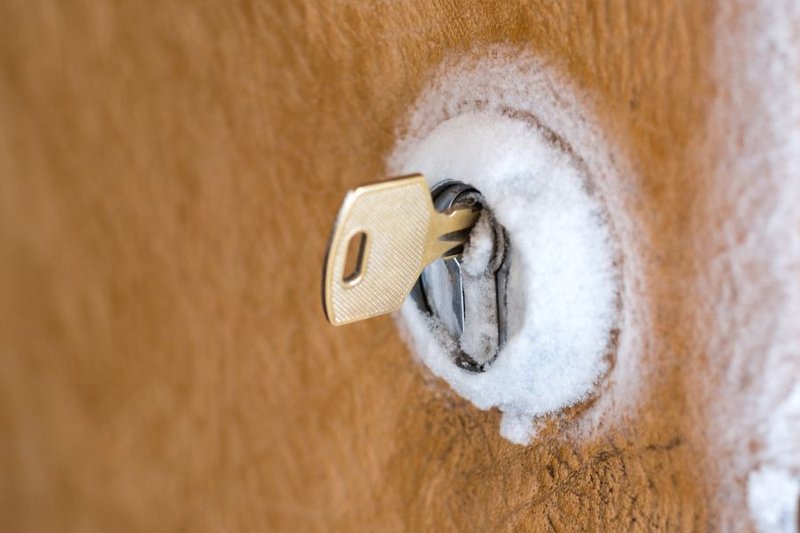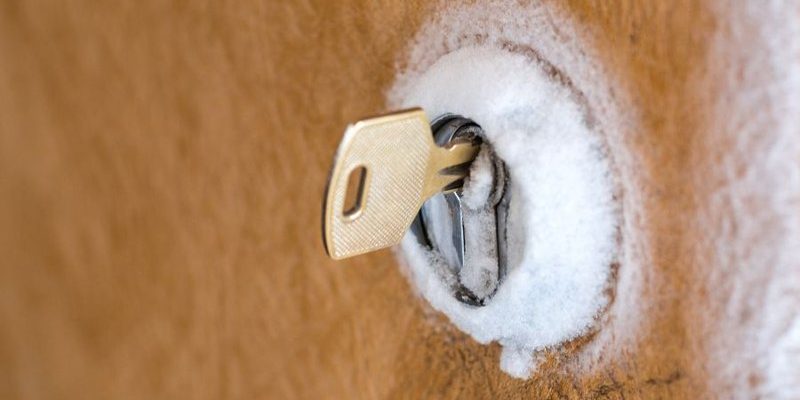
Here’s the thing: even the most reliable Yale, Kwikset, or Schlage deadbolt can jam up when the temperature drops. It’s not about brand loyalty or fancy smart lock codes. When moisture finds its way inside your lock and freezes, you’re left outside fiddling with keys, wondering if you’ll need a locksmith—or a sledgehammer. But before you start planning your next break-in (or out), let’s talk about why deadbolts freeze, how you can prevent it, and what to do when you’re standing outside with a lock that refuses to budge.
Why Deadbolts Freeze: The Science Behind It
A frozen deadbolt isn’t just bad luck. It’s a sneaky mix of winter weather, condensation, and temperature swings working against you. Water vapor—think foggy breath or melting snow—can seep into the tiniest gaps in your deadbolt. When the temperature drops fast, that moisture freezes solid inside the lock mechanism. Suddenly, your key won’t turn, no matter how much you wiggle it.
It’s not just rain or snow you have to worry about. Humidity inside your home, especially during freeze-thaw cycles, can also migrate into the lock through small gaps or the thumbturn. This is especially common with older doors or deadbolts that aren’t tightly sealed. As the mechanism gets colder than the outdoor air, water inside freezes before you can say “Why me?”
Not all locks freeze equally, either. Keyless or smart locks—like those with batteries or code pads—aren’t immune. They have moving parts and seams where water can sneak in. The more you use the lock, the more wear and tear creates tiny pathways for moisture. And if you use a universal deadbolt installation kit, sometimes the fit isn’t perfect, making freezing even more likely.
Common Signs Your Deadbolt Is Frozen
You might be wondering how to spot a frozen deadbolt before you’re stranded outside. There are a few telltale signs. The most obvious is when you insert your key and it refuses to turn, or it only turns partway. Sometimes, the key goes in but feels oddly gritty or stiff. Other times, you’ll hear a faint crunching sound as the frozen parts grind against each other.
In some cases, the deadbolt’s thumbturn (the part you use from inside) will move freely, but the lock itself won’t engage—almost like something invisible is blocking it. For electronic or smart deadbolts, you might see battery power warnings, blinking lights, or hear weak motor noises as the lock tries to work against the ice. That’s usually a hint the mechanism inside is frozen solid.
Honestly, if your deadbolt worked fine yesterday and jams up right after a cold snap or snowy night, it’s probably frozen. It’s easy to mistake this for a worn-out lock or bad key, so check the weather, too. Did things suddenly get icy? That’s your cue.
How to Safely Thaw a Frozen Deadbolt
So, you’re standing in front of your door, breathing clouds of steam, and your deadbolt is frozen tight. Here’s what to do—without ruining your lock or making things worse.
- Warm the key—The easiest trick is to heat your metal key with a lighter (hold it with pliers for safety). Push the warm key into the lock and see if it melts the ice inside. Sometimes, this is all it takes to get things moving.
- Use lock de-icer—Available at hardware stores or gas stations, lock de-icer is made to thaw frozen locks fast. It usually comes in a tiny bottle with a nozzle. Squirt it into the keyhole, wait a minute, then try your key again. De-icer works by lowering the freezing point of the water and breaking up ice inside the lock.
- Try a hairdryer—If you can run an extension cord outside, warming the lock with a hairdryer works surprisingly well. Blow hot air directly onto the deadbolt for a couple of minutes, then test the key. Be patient—it can take longer than you think if temperatures are far below freezing.
- Avoid boiling water—It’s tempting, but pouring boiling water on your lock is a bad idea. Sure, it might melt the ice now, but any leftover moisture can freeze again—possibly even worse than before.
If you’re dealing with an electronic or smart deadbolt, don’t try to force the keypad or battery cover off while it’s frozen. That’ll make things worse. Instead, use the same external warming tricks. And if your lock runs on batteries, cold temperatures can drain them faster—so keep spare batteries handy just in case.
Preventing Your Deadbolt From Freezing
Prevention is way easier than standing in the cold, battling a frozen lock. The key is to keep moisture out and moving parts protected before winter hits.
- Lubricate your lock regularly—Use a graphite-based lock lubricant in the keyhole and deadbolt mechanism. Graphite repels moisture and keeps the mechanism moving smoothly. Spray a short burst, insert the key, and work it in and out several times to spread the graphite throughout the lock.
- Seal gaps around your door—Check for drafts or visible gaps at the top, sides, and bottom of your door. Use weatherstripping to stop cold air and moisture from getting inside. The less water gets near your lock, the less chance it has to freeze.
- Install a lock cover—Special covers or simple homemade shields (even a piece of duct tape on frigid nights) help keep snow and sleet out of the mechanism. They’re especially helpful for outside-facing doors and outbuildings where wind blows moisture directly onto the lock.
- Upgrade to weatherproof deadbolts—If you’re constantly fighting frozen locks, consider replacing your standard deadbolt with a model rated for extreme weather. Brands like Schlage and Yale offer weather-resistant deadbolts and smart locks with tighter seals and better waterproofing. It’s a bigger investment, but less hassle long-term.
Honestly, none of these steps take much time, but they can save you a world of trouble once the temperature drops.
When to Call a Locksmith
Sometimes, despite your best efforts, the deadbolt just won’t budge. If you’ve tried thawing, de-icing, and lubricating, and nothing works—or if the key breaks off in the lock—it’s time to call in a pro. Locksmiths have special tools (and a lot more patience) for dealing with frozen and jammed locks.
You might be tempted to try picking or forcing the deadbolt, but honestly, that can lead to bigger headaches. Forcing a frozen lock can bend your key, snap the internal pins, or even damage the door frame. All of those mean more expensive repairs down the road.
A good locksmith will not only unfreeze your existing lock but can also check if there’s underlying damage or if you’re due for an upgrade. Sometimes, repeated freeze-thaw cycles can wear out the mechanism for good, making replacement the smarter option anyway.
How to Maintain Your Deadbolt Year-Round
Keeping your deadbolt working smoothly isn’t just a winter job. Regular upkeep helps prevent freezing and ensures your lock works when you need it most.
- Clean the keyhole—Every few months, blow dust and dirt out of the keyhole with compressed air. Gritty buildup is a magnet for moisture and can speed up freezing in the cold.
- Check for wear—If your key feels loose or the deadbolt sticks, inspect for visible signs of wear. Worn parts hold moisture, making freezing more likely. Swap out old or bent keys, and keep a spare hidden somewhere safe (but not outside in a place where it can freeze).
- Test battery-operated locks—For smart deadbolts, test and change the batteries before winter sets in. Cold weather drains batteries faster, so it’s smart to have extras nearby.
Let me explain: consistency matters. A lock that sees regular attention is far less likely to betray you on a bitter winter night.
Are Some Deadbolts Better Than Others for Cold Weather?
Not all deadbolts are created equal. Some brands and styles handle winter much better than others. For example, Schlage deadbolts are known for their sturdy, weather-resistant design, while Kwikset models with SmartKey security have tight mechanisms that help block moisture. Meanwhile, keyless and smart deadbolts bring their own quirks, especially with batteries and electronic parts that can fail or freeze up.
If you’re shopping for a new lock, look for features like:
- Weather sealing
- Anti-corrosion finishes
- Battery backup for smart locks
- Simple mechanical override (for when tech fails in the cold)
Universal deadbolt kits are tempting because they fit most doors, but you might sacrifice some weatherproofing if the fit isn’t perfect. Branded deadbolts, designed for your door type, often do a better job sealing out moisture.
Quick Comparisons: Smart vs Traditional Deadbolts in Winter
Let’s get real—no one wants to fumble with a frozen keypad or drained batteries in a blizzard. Here’s a side-by-side look at how traditional and smart deadbolts handle winter’s worst.
| Traditional Deadbolt | Smart Deadbolt |
| Simple design, fewer points of failure | Convenient codes, but batteries can die fast in cold |
| Easy to thaw with key or de-icer | May need a backup key if electronics freeze |
| Often seals better if installed right | Weatherproof models available, but pricier |
Honestly, if you care most about reliability in the cold, a traditional deadbolt—kept clean and lubricated—rarely lets you down. But for tech fans, a well-sealed smart lock (with fresh batteries) can do fine, too. The trick is knowing how to troubleshoot, no matter what you use.
Wrap-Up: Keep Your Lock (And Yourself) Out of the Cold
Frozen deadbolts are a classic winter headache, but they’re not unbeatable. With a little know-how—like keeping moisture out, using the right lube, and warming things up when needed—you can keep your lock working through the worst cold snaps. Whether you’re dealing with a sturdy Schlage, a universal deadbolt, or a battery-powered smart lock, regular maintenance and a bit of prevention go a long way. Next time the temperature drops, you’ll be ready to head inside, no drama required. Stay warm—and may your deadbolt always turn easily!
